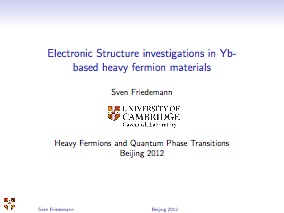Institute of Physics, Chinese Academy of Sciences


Nov 10-12, 2012

Electronic Structure investigations in Yb-based heavy fermion materials
Sven Friedemann
University of Cambridge, UK
Heavy-fermion materials provide outstanding opportunities to study quantum critical phenomena. This stems mainly from the fact that in these systems the ground state can be tuned with relative easiness. This allows to address fundamental questions of quantum criticality and physics of correlated systems. For instance, the prototypical materials YbRh2Si2 features a quantum critical points which requires descriptions that go beyond the conventional order-parameter notion. Here, electronic structure studies played a key role to identify the intriguing physics of YbRh2Si2. I will discuss Hall effect measurements which find a reconstruction of the Fermi surface in the zero temperature limit. Furthermore, energy-over-temperature scaling deduced from the Hall effect measurements indicate that the fluctuations between the two different Fermi surface configurations is underlying the finite temperature quantum critical behavior.
The newly discovered heavy-fermion material YbNi4P2 appears to be the first example of a truly continuous quantum phase transition from a ferromagnetic state to a paramagnetic state. Remarkably, this is in contrast to theoretical predictions which exclude ferromagnetic quantum critical points in metallic systems. However, these theoretical considerations are valid for two and three dimensional materials only. I will present electronic structure calculations in conjunction with quantum oscillation measurements. These comprehensive electronic structure studies reveal a quasi-one-dimensional electronic structure which might be the key to understand the presence of a ferromagnetic quantum critical point.

click the picture to download
contact
Yi-feng Yang, Institute of Physics, Chinese Academy of Sciences, P. O. Box 603, Beijing 100190, China. Tel: (86)-10-82649448, (86)-18911600270; Fax: (86)-10-62553698; Email: yifeng@iphy.ac.cn


